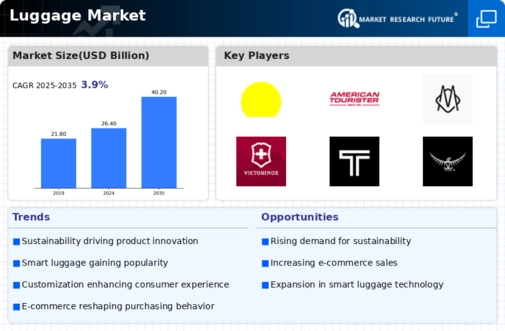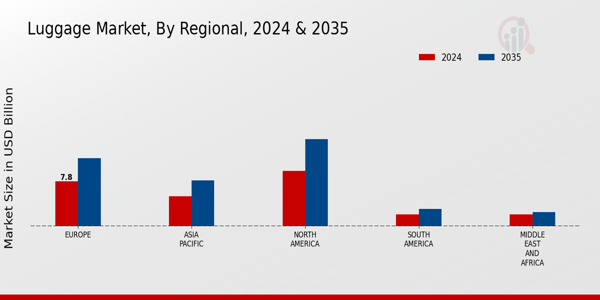Market Growth Projections
The Global Luggage Market Industry is poised for substantial growth, with projections indicating a market value of 26.4 USD Billion in 2024 and an anticipated increase to 40.2 USD Billion by 2035. This growth trajectory suggests a compound annual growth rate of 3.9% from 2025 to 2035. The market's expansion is influenced by various factors, including rising travel demand, technological advancements, and changing consumer preferences. As the industry evolves, stakeholders must remain attuned to emerging trends and consumer needs to capitalize on growth opportunities.
Rising Global Travel Demand
The Global Luggage Market Industry experiences a notable surge in demand, driven by an increase in global travel. In 2024, the market is projected to reach 26.4 USD Billion, reflecting a growing inclination towards leisure and business travel. This trend is further supported by the expansion of low-cost airlines and the proliferation of travel packages, making travel more accessible. As international tourism rebounds, consumers are increasingly investing in high-quality luggage that meets their travel needs. This shift not only enhances the market's growth potential but also indicates a shift towards premium luggage options that offer durability and style.
Growth of E-commerce and Online Retail
The rise of e-commerce significantly impacts the Global Luggage Market Industry, as consumers increasingly prefer online shopping for convenience and variety. Online platforms provide access to a broader range of products, allowing consumers to compare prices and features easily. This trend is particularly relevant in the luggage sector, where consumers seek specific functionalities and styles. The growth of online retail is expected to drive market expansion, with projections indicating a market value of 40.2 USD Billion by 2035. As e-commerce continues to flourish, brands that effectively leverage online channels may capture a larger share of the market.
Sustainability Trends in Luggage Production
Sustainability emerges as a pivotal driver within the Global Luggage Market Industry, as consumers increasingly favor eco-friendly products. Brands are responding by utilizing sustainable materials and ethical manufacturing processes, appealing to environmentally conscious travelers. This shift towards sustainability is not merely a trend; it reflects a broader societal change in consumer behavior. Companies that prioritize sustainability may experience enhanced brand reputation and customer loyalty. As the market evolves, the demand for sustainable luggage options is likely to grow, potentially influencing market dynamics and leading to an increase in market share for eco-friendly brands.
Technological Advancements in Luggage Design
Innovations in luggage design significantly influence the Global Luggage Market Industry. Manufacturers are increasingly integrating technology into their products, such as smart luggage equipped with GPS tracking, built-in charging ports, and biometric locks. These advancements cater to the tech-savvy traveler, enhancing convenience and security. As consumers prioritize functionality alongside aesthetics, the demand for technologically advanced luggage is likely to rise. This trend is expected to contribute to the market's growth, with projections indicating a compound annual growth rate of 3.9% from 2025 to 2035. The integration of technology not only attracts new customers but also encourages brand loyalty among existing consumers.
Changing Consumer Preferences and Lifestyle Trends
The Global Luggage Market Industry is shaped by evolving consumer preferences and lifestyle trends. As travel becomes an integral part of modern life, consumers are increasingly seeking luggage that aligns with their lifestyle needs. This includes preferences for lightweight, versatile, and stylish options that cater to both short trips and extended travel. Additionally, the rise of experiential travel influences purchasing decisions, as consumers prioritize functionality and aesthetics. This shift in consumer behavior is likely to drive demand for innovative luggage solutions, further propelling market growth and diversification in product offerings.











